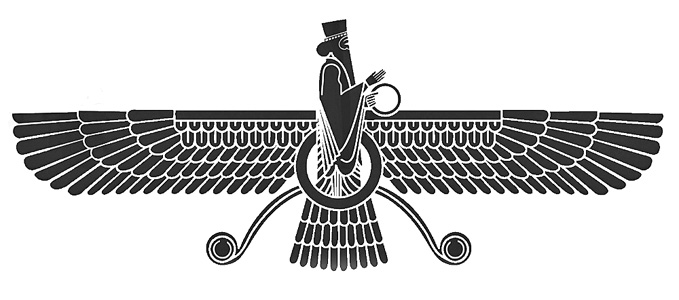PT Reporter, Khushroo Mehta, catches up with Panthaky Of Deolali Agiary, Ervad Nouzer Mehenty, who shares his wisdom regarding the importance of various symbols pertaining to the glorious Zoroastrian religion.
PT: What is the significance and relevance of Asho Frahohar?
Panthaky Mehenty: The Farohar is depicted as a bird on two legs with outstretched, protecting wings. The words ‘Fravashi’, ‘Fravardin’ and ‘Arda-Fravash’ are in relevance to ‘Farohar’. The Farohar is a symbol of the ‘Fravashi’-The Divine Light of Ahura Mazda accompanying each soul or Urvan and which is the ‘Guardian angel’ of every human being. The symbol appears to be flying towards heaven to show that the human spirit can soar to transcendental heights. The symbol of Farohar inspires us to endeavour towards the true goal of life – Spiritual Perfection. This divine symbol depicts Ahu, Ahura and Mazda.
PT: Why are Asho Frohar’s stickers/emblems used by Zarthostis?
Panthaky Mehenty: Zoroastrians use the symbol of Farohar prominently on all their belongings – especially cars – because they consider it a divine talisman of power and protection. Some use it to proudly proclaim to the world that they are ‘Proud to be Zarthosthis’. Some Zoroastrians use the symbol of Farohar as an amulet, suggesting the protection afforded by the magical bird ‘Peshoparena’.
PT: What is the ‘Kavyani Zando’? What is its significance in Zoroastrian religion?
Panthaky Mehenty: ‘Kaveh Ahangar’ was an old man, a poor blacksmith who had eighteen sons. Seventeen of them had been killed by the soldiers of the legendary cruel Zohak, and when they took even his last son away, he fearlessly confronted Zohak in his court and forced him to release his son. Kaveh was an ordinary blacksmith but he was blessed with a spiritually evolved soul and was sent to fulfil an important mission in the world. He motivated the people to join him in his fight against evil, symbolised by the cruel Zohak.
Kaveh came before the people in the streets. He took a piece of leather which was tied to his feet, tied it to a long stick, made a flag of it and lifting it proudly, encouraged the people to join him, to find King Faredoon and help him kill the cruel Zohak. Kaveh took the flag, along with an army of thousands of people and went to Faredoon. Faredoon noticed that white light of Sarosh Yazad flowed from the sky and descended on Kaveh’s head and his flag too was surrounded by a bright light. This flag thus became the national flag of all Iranian dynasties and became famous as the ‘Kavyani Zando’ (Zando=Flag). This is the story of the Kavyani Zando and its significance in the Zoroastrian religion.
PT: Why is the Kavyani Zando paraded on select days around Surat and Navsari ?
Panthaky Mehenty: The Sassanian Kavyani Zando (The Royal Flag of Iran SarZamin) is still considered by Parsi Zarthostis to be extremely sacred and full of talismanic, protective powers. What we witness in Surat i.e. garlanding the Surat Kavyani Zando by each and every Parsi household and then hoisting it on the Paak Atash Behram Padshah Saheb are the vestiges of our Sassanian Iranian tradition of giving love, respect and showing loyalty to the Shahenshah of Iran and to the beloved Holy Royal Flag of our Madar Vatan, Iran.
PT: Could you share the symbolic meaning attached to the various parts of the ‘SAKLI Toran’ that is hung on the door of the Kebla?
Panthaky Mehenty: The silver toran which is hung on the door of the Paak Atash Padshahno Keblo has different images embossed on it. Parsi Zarthostis, for centuries have considered each of these depicted icons to be sacred, auspicious, full of barkat (prosperity) and worthy of veneration. Few of the religious icons embossed on the silver toran (garland) are Coconut or Date Palm tree, Varasiaji, Cow, Cresent Moon (bijno chand), Atash nu Patru, Rising Sun (Khurshed Yazad), and so on.
PT: Why is the sword, chamach and a rod with cow’s head, always hung up on the walls of the Kebla?
Panthaky Mehenty: I will give you this answer from excerpts of the Parsi Aawaz as under:
“તમો જાણો છો કે આતશબહેરામ સાહેબ એક જીવતી જાગતી સંસ્થા છે અને તે પાક સંસ્થાઓ તેઓ માત્ર બસ્તેકુસ્તીઆનોનીજ ખીદમતમાં ઉભેલી નથી પરંતુ કુલ ગેતીના ઉધ્ધારનું કુદરતની કાળી બાજુ સામેની લડતનું કર્તવ્ય રાતોદીન નીયમીત બજાવે છે. આતશબહેરામ પાદશાહો જરથોસ્તી દીનના રથેસ્તારો છે અને જે અણદીઠ શસ્ત્રો મારફતે આવા પાદશાહો કાળી કુદરતની સામે ઝઝુમે છે, તેની નીશાની તરીકે પાદશાહના કેબલામાં લડાઇના હથીઆરો મુકવામાં આવે છે.”
– (જેહાંગીરજી સોહરાબજી ચીનીવાલા, પારસી આવાઝ, dated 28-10-1951, page 8)
Roughly translated as under: The Atash Behram is a living institution, meant not only for the welfare of mankind, but for the benefit of the entire universe; it defends one and all from evil forces, and it stands as a protective guard against them. The Atash Behram Padshahs are the protectors of our Zoroastrian faith and thus, they use the weapons of war against evil forces, which are exhibited on the walls of the Kebla in each Agiary.
- Panchgani’s Choksi Dar-e-Meher Celebrates 94th Salgreh - 27 April2024
- Ava Yazad Parab At Thana Patell Agiary - 30 March2024
- Cowasji Patell Agiary Celebrates 244th Salgreh - 24 February2024
